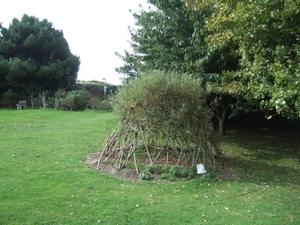Weeping Trees and Contented Kittens
March 9, 2022
Humanity's association with the willow has been a long one and, for humanity at least, a profitable one. There is evidence of use of willow all the way back to Paleolithic times. It is only comparatively recently that we have tamed and cultivated it.
The most recognized member of this family is the Weeping Willow. While the original Weeping Willow is native to China, it and hybrids of it have been introduced all over the world.

Another popular form of willow for the garden is the Pussy Willow (S. discolor) which left to its own will grow into a large shrub but can be pruned to keep it to a more manageable size. I still have enough of the kid in me that I always go out when the pussy willows start to peek in the spring to pet the kittens' noses.
There is also a weeping form of the pussywillow that would be a stunning focal point for a round bed.
![[Public domain], via Wikimedia Commons [Public domain], via Wikimedia Commons](https://echoesofthegarden.net/wp-content/uploads/2017/03/Pussy_willow_branch-web.jpg)
Here's a good description of the white willow and this site has a good description and information on twelve different species of willow, including the Corkscrew Willow.
The Corkscrew Willow or Curly Willow (S. matsudana 'Tortuosa') is an unusual and beautiful tree. It comes in two forms- upright and weeping. This site has information on how to grow it. She does say that it's brittle and short-lived. I never had any problems with my Weeping Curly Willow and as of last year -twenty years after I planted it- it was still going strong.
The 'Kilmarnock' Willow (S. caprea 'Kilmarnock') is a miniature form of the weeping willow that grows only 4'-8' tall. It does have a 6'-8' foot diameter, so give it pride of place in the center of your round bed or knot garden instead of in a foundation bed against your house.
While this is a discussion on the design principles of permaculture, it uses willow as its example so it's pertinent on a couple of levels.
One of the most wonderful and fascinating things about willows is that they take root and grow so quickly and easily that you can make “living structures” with them.

This video documents the planting of one of these structures. I also haven't watched this one yet (my “to watch” list has grown exponentially since I started this blog!) If you get to it before I do, please let me know how it is in the comments below. Thanks!
If you decide to build one for yourself, this video tells you how to take care of it after it has started growing.
And in case you need a bit of decoration for your garden- there are willow sheep for the bucolic win.
One thing I have always wanted to do is create a “secret room” under the branches of a really big Weeping Willow. Use lattice or pallets to make a small three sided structure just big enough to sit and read a book in, plant some upright willow cuttings around it and weave the willow branches through the holes in the structure. Maybe I'll plant a Weeping Willow this year so I can finally do it.
Add
to
your
garden
Thanks for stopping by.

